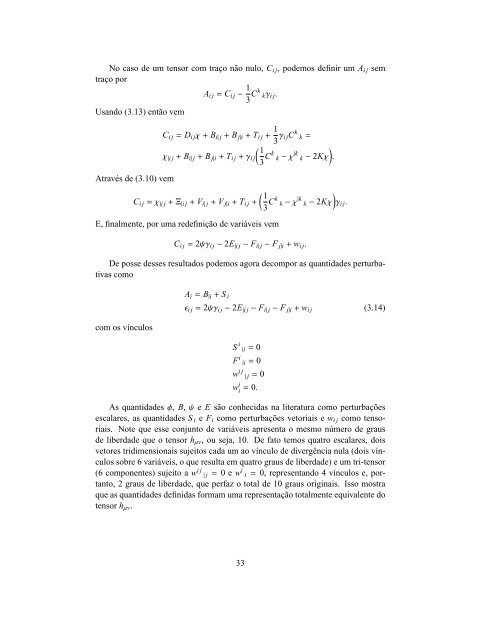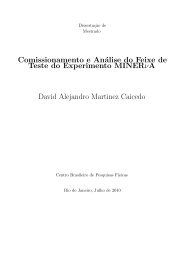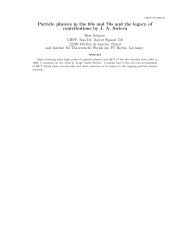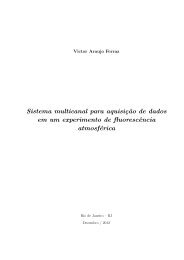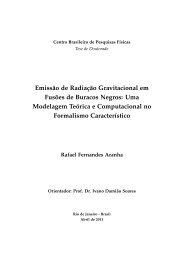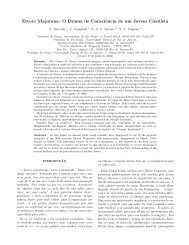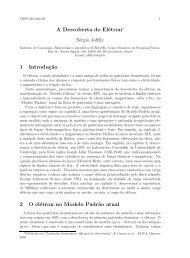Teoria de Perturbações Invariantes de Calibre em ... - CBPFIndex
Teoria de Perturbações Invariantes de Calibre em ... - CBPFIndex
Teoria de Perturbações Invariantes de Calibre em ... - CBPFIndex
You also want an ePaper? Increase the reach of your titles
YUMPU automatically turns print PDFs into web optimized ePapers that Google loves.
No caso <strong>de</strong> um tensor com traço não nulo, C i j , po<strong>de</strong>mos <strong>de</strong>finir um A i j s<strong>em</strong><br />
traço por<br />
Usando (3.13) então v<strong>em</strong><br />
A i j = C i j − 1 3 Ck kγ i j .<br />
Através <strong>de</strong> (3.10) v<strong>em</strong><br />
C i j = D i j χ+ B i| j + B j|i + T i j + 1 3 γ i jC k k=<br />
( 1<br />
)<br />
χ |i j + B i| j + B j|i + T i j +γ i j<br />
3 Ck k−χ |k k− 2Kχ.<br />
( 1<br />
C i j =χ |i j +Ξ |i j + V i| j + V j|i + T i j +<br />
3 Ck k−χ |k k− 2Kχ)<br />
γ i j .<br />
E, finalmente, por uma re<strong>de</strong>finição <strong>de</strong> variáveis v<strong>em</strong><br />
C i j = 2ψγ i j − 2E |i j − F i| j − F j|i + w i j .<br />
De posse <strong>de</strong>sses resultados po<strong>de</strong>mos agora <strong>de</strong>compor as quantida<strong>de</strong>s perturbativas<br />
como<br />
com os vínculos<br />
A i = B |i + S i<br />
ǫ i j = 2ψγ i j − 2E |i j − F i| j − F j|i + w i j (3.14)<br />
S i |i= 0<br />
F i |i= 0<br />
w i j | j= 0<br />
w i i = 0.<br />
As quantida<strong>de</strong>sφ, B,ψeEsão conhecidas na literatura como perturbações<br />
escalares, as quantida<strong>de</strong>s S i e F i como perturbações vetoriais e w i j como tensoriais.<br />
Note que esse conjunto <strong>de</strong> variáveis apresenta o mesmo número <strong>de</strong> graus<br />
<strong>de</strong> liberda<strong>de</strong> que o tensor h µν , ou seja, 10. De fato t<strong>em</strong>os quatro escalares, dois<br />
vetores tridimensionais sujeitos cada um ao vínculo <strong>de</strong> divergência nula (dois vínculos<br />
sobre 6 variáveis, o que resulta <strong>em</strong> quatro graus <strong>de</strong> liberda<strong>de</strong>) e um tri-tensor<br />
(6 componentes) sujeito a w i j | j=0 e w i i=0, representando 4 vínculos e, portanto,<br />
2 graus <strong>de</strong> liberda<strong>de</strong>, que perfaz o total <strong>de</strong> 10 graus originais. Isso mostra<br />
que as quantida<strong>de</strong>s <strong>de</strong>finidas formam uma representação totalmente equivalente do<br />
tensor h µν .<br />
33


